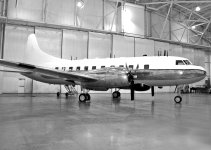-
Update – 12:30 PM EST
Attachments are now working, and all members can once again upload files.
We are currently testing URL redirects and other miscellaneous features across the site.
Thank you for your continued patience and support during this migration.
Prefer a darker look? You can switch between light and dark modes in your account settings:
smith-wessonforum.com/account/preferences
You are using an out of date browser. It may not display this or other websites correctly.
You should upgrade or use an alternative browser.
You should upgrade or use an alternative browser.
Mystery Plane IX -- Convair T-29 Flying Classroom
- Thread starter Kernel Crittenden
- Start date
The maker is Convair, I don't know the model, probably used
for VIP travel. How did I do?
for VIP travel. How did I do?
Dennis The B
US Veteran
Convair 580? If so, we flew on them at Ford for years.
O.K. I think I got it. Convair 240, first flight March 16, 1947,
engines are Pratt & Whitney R-2800 Double Wasp radial
engines. Used for VIP's.
engines are Pratt & Whitney R-2800 Double Wasp radial
engines. Used for VIP's.
REM 3200
US Veteran
I don't think VIP transport with a radar dome on it.
Probably anti-sub warfare.
Probably anti-sub warfare.
Fat Frank
US Veteran
Convair T-29A "Flying Classroom" - Navigation trainer.
First Flight: 22 Sep 1949
Powered by two Pratt & Whitney R-2800 Radial engines.
First Flight: 22 Sep 1949
Powered by two Pratt & Whitney R-2800 Radial engines.
Fat Frank
US Veteran
That particular plane is at the Air & Space Museum, just inside the Kenny Gate at Offutt AFB. (Spent 8 years in lovely Nebraska).
Oops. Correction. They moved it. The "new" museum is now near Ashland, down near Eugene Mahoney State Park.
What's up with that?
Oops. Correction. They moved it. The "new" museum is now near Ashland, down near Eugene Mahoney State Park.
What's up with that?
Last edited:
zzzippper
Well-known member
You guys have me beat hands down. I would have guessed a Douglas DC4.
steveno
Well-known member
we had a T-29 at Rhein Main AB for a while. we got a call that the UHF radio was keyed the minute it was turned on. so we go out to the airplane and everything was working just the way it was supposed to and the crew chief agreed. we no longer got back to the shop when we were told to go back out to the airplane with the same problem. this went on for a while and it turns out that every time we were working in the cockpit that crew chief had moved his tool box to where he was working. it turns out that under the carpet there was floor mounted mic switches under the work stations and he kept putting is tool box on one them. with the interphone switch on UHF and the tool box on the floor switch every time the UHF was keyed. since the airplane was no longer used for training we disconnected the floor mounted switch and everybody was happy.
we also had some C-131 airplanes for medevacs. which is basically the same airplane except it had weather radar
we also had some C-131 airplanes for medevacs. which is basically the same airplane except it had weather radar
LVSteve
Well-known member
IIRC the engine installation was rather unusual for a radial. Instead of having cooling gills that opened on the cowling, all the cooling air passed backward in the nacelle to a venturi area that was fed with the hot exhaust gasses. This accelerated the the air out of a pair of nozzles at the rear of the nacelle and provided extra thrust. This extra thrust and the low drag of the clean nacelles gave the aircraft better cruising speed than the comparable aircraft like the Martin 2-0-2
THE PILGRIM
Well-known member
I have been to Sweetwater in one.
Several times.
Several times.
williamlayton
Well-known member
Nose gear gave me a clue.
Blessings
Blessings
Coldshooter
Well-known member
NASA had a similar airframe set up with the APS94 SLAR for sea ice research it was a C131.
The Coast Guard had a few, most of which came from ANG units or Davis-Monthan.
The HU-16E Albatross was nearing the end of it’s service life due to main wing spar time limits. The new jet was not yet available, and something was needed to fill the void. The C-131A was selected as the interim aircraft. The Coast Guard designation was HC-131A.
This particular aircraft was on display at the Pueblo Air Museum a few years ago:


The HU-16E Albatross was nearing the end of it’s service life due to main wing spar time limits. The new jet was not yet available, and something was needed to fill the void. The C-131A was selected as the interim aircraft. The Coast Guard designation was HC-131A.
This particular aircraft was on display at the Pueblo Air Museum a few years ago:


Last edited:
I thought it resembled.....
I thought it resembled a DC3.
You guys have me beat hands down. I would have guessed a Douglas DC4.
I thought it resembled a DC3.
Coldshooter
Well-known member
Had a bit more time to look over. No National insignia no N number looks like a standard Birchwood hangar interior. Interesting story?
Kernel Crittenden
US Veteran, Absent Comrade
Ding, ding, ding….. the winner is Fat Frank (anyone surprised?). Took him a mere 57 minutes. The plane is in fact Convair T-29A Flying Classroom, 50-0190, located at the SAC museum in Nebraska. The T-29 is a true mystery plane in the sense that it’s barely known outside of USAF/USN circles, though it played a key role in training our nation’s navigators and bombardiers for twenty-five years during the height of the Cold War.
T-29A 50-0190 at the SAC museum in Nebraska.

I knew very little about this plane before this thread. Apologies for writing such a long narrative and taking so long to respond, but this plane has such an interesting history and it took me a while to noodle thru it all. The T-29 is sort of the “Forest Gump” of airplanes. It was everywhere in it‘s time, hardly noticed, and today largely forgotten. Built in large numbers and used for a multitude of differing applications and one-off projects. I can only touch on a few here.
The USAF T-29 Flying Classroom and C-131 Samaritan were derived from a family of civilian transport aircraft developed by Convair immediately after WWII. The first being the civilian CV-110, a single example of which was built and flew July 8, 1946. It was followed by the CV- 240 / 340 / 440 which remained in continuous production until 1958.
1,077 of all types were built, both military and civilian. The CV-110 / 240 / 340 / 440 all used the famous Pratt & Whitney R-2800 Double Wasp air cooled radial engine. The same engine used to power so many of our best late-war high performance war-winning fighters and bombers. Such as the F4U Corsair, F6F Hellcat, P-47 Thunderbolt, P-61 Black Widow, A-26 Invader, and B-26 Marauder. A massively successful and powerful engine.
50-0190's Pratt & Whitney R-2800 Double Wasp.

A total of 508 (!) military T-29 and C-131 versions of all types were built for the USAF and USN. All T-29’s were derived from the CV-240. The C-131 from the CV-240 and the otherwise identical (except for details) CV-340 / 440. Two XT-29’s were built and the first flight took place on September 22 1949. (Later these were brought up to T-29A standard.)
The T-29A (240-17) was first military model to enter the inventory. It was an unpressurized navigation, bombardment, radar, and radio trainer; 46 were built. In a belly faring it had a Western Electric AN/APS-23 search radar, which was also the main nav radar in the B-36, B-47, B-52, and B-66, as well as the C-130 and KC-135. T-29A had stations for 14 navigator/bombardier and 1 radio operator students.
A restored nav table in 50-0190. There were 14 such stations in the T-29A.

The T-29B (240-27) was the first pressurized version. It flew in 1951. It had three astrodomes instead of four, the forward one being modified to house a MIL-S-5807A sextant periscope in place of one astrodome as normally found on the T-29A. 105 T-29B’s were built. These had provisions for 10 navigator and 4 radio students.
The MIL-S-5807A sextant periscope.

The T-29C (240-27) flew in 1952, of which 119 were built. The T-29D (240-52) followed that same year and was developed for advanced navigation / bombardment training (92 built) and had no astrodomes. Later 12 D’s becoming ET-29D’s with special ECM equipment (these were used to train EWO‘s for the Cold War era RB-47 and RB-66 radar jamming aircraft).
A T-29C taxis at Tempelhof airport in Berlin in 1974.

T-29A 50-0190 at the SAC museum in Nebraska.
I knew very little about this plane before this thread. Apologies for writing such a long narrative and taking so long to respond, but this plane has such an interesting history and it took me a while to noodle thru it all. The T-29 is sort of the “Forest Gump” of airplanes. It was everywhere in it‘s time, hardly noticed, and today largely forgotten. Built in large numbers and used for a multitude of differing applications and one-off projects. I can only touch on a few here.
The USAF T-29 Flying Classroom and C-131 Samaritan were derived from a family of civilian transport aircraft developed by Convair immediately after WWII. The first being the civilian CV-110, a single example of which was built and flew July 8, 1946. It was followed by the CV- 240 / 340 / 440 which remained in continuous production until 1958.
1,077 of all types were built, both military and civilian. The CV-110 / 240 / 340 / 440 all used the famous Pratt & Whitney R-2800 Double Wasp air cooled radial engine. The same engine used to power so many of our best late-war high performance war-winning fighters and bombers. Such as the F4U Corsair, F6F Hellcat, P-47 Thunderbolt, P-61 Black Widow, A-26 Invader, and B-26 Marauder. A massively successful and powerful engine.
50-0190's Pratt & Whitney R-2800 Double Wasp.
A total of 508 (!) military T-29 and C-131 versions of all types were built for the USAF and USN. All T-29’s were derived from the CV-240. The C-131 from the CV-240 and the otherwise identical (except for details) CV-340 / 440. Two XT-29’s were built and the first flight took place on September 22 1949. (Later these were brought up to T-29A standard.)
The T-29A (240-17) was first military model to enter the inventory. It was an unpressurized navigation, bombardment, radar, and radio trainer; 46 were built. In a belly faring it had a Western Electric AN/APS-23 search radar, which was also the main nav radar in the B-36, B-47, B-52, and B-66, as well as the C-130 and KC-135. T-29A had stations for 14 navigator/bombardier and 1 radio operator students.
A restored nav table in 50-0190. There were 14 such stations in the T-29A.
The T-29B (240-27) was the first pressurized version. It flew in 1951. It had three astrodomes instead of four, the forward one being modified to house a MIL-S-5807A sextant periscope in place of one astrodome as normally found on the T-29A. 105 T-29B’s were built. These had provisions for 10 navigator and 4 radio students.
The MIL-S-5807A sextant periscope.
The T-29C (240-27) flew in 1952, of which 119 were built. The T-29D (240-52) followed that same year and was developed for advanced navigation / bombardment training (92 built) and had no astrodomes. Later 12 D’s becoming ET-29D’s with special ECM equipment (these were used to train EWO‘s for the Cold War era RB-47 and RB-66 radar jamming aircraft).
A T-29C taxis at Tempelhof airport in Berlin in 1974.
Attachments
-
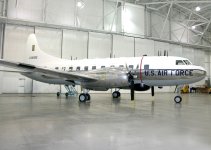 Convair T-29A, 50-0190, right in hanger x.jpg285.6 KB · Views: 701
Convair T-29A, 50-0190, right in hanger x.jpg285.6 KB · Views: 701 -
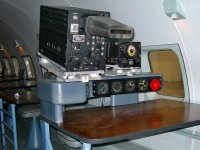 Convair T-29B Flying Classroom, 51-50190, Navigation Student's Table x.jpg269.1 KB · Views: 704
Convair T-29B Flying Classroom, 51-50190, Navigation Student's Table x.jpg269.1 KB · Views: 704 -
 Convair T-29, MIL-S-5807A Sextant Periscopic, D-1 mount x.jpg213.1 KB · Views: 698
Convair T-29, MIL-S-5807A Sextant Periscopic, D-1 mount x.jpg213.1 KB · Views: 698 -
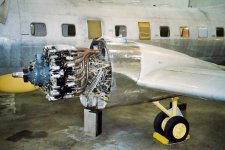 Convair T-29A, 50-0190 Flying Classroom, left side engine cowling off x.jpg265.7 KB · Views: 698
Convair T-29A, 50-0190 Flying Classroom, left side engine cowling off x.jpg265.7 KB · Views: 698 -
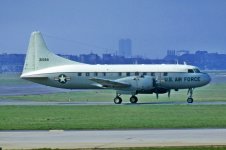 Convair T-29C (240-27), Tempelhof Berlin 1974 x.jpg269.1 KB · Views: 695
Convair T-29C (240-27), Tempelhof Berlin 1974 x.jpg269.1 KB · Views: 695
Kernel Crittenden
US Veteran, Absent Comrade
A T-29B over Oslo Sweden in 1969. This shot shows Western Electric AN/APS-23 search radar really well.

The VT-29A/B/C/D was built for staff transport, with a total of 212 so configured. C-131A (240-53) Samaritans, 26 built, were medical air evacuation transports. Two became VC-131A’s with plush VIP interiors. The C-131B (340-70) was 48 seat transport and electronic test-bed (36 built). The C-131D (340-67/-68/-79/440-79) a 44-seat passenger transport, with 33 built. Beginning in 1954 two YC-131C (CV-340-36/64) test beds were flown with Allison 501D-13 (T38) turbo-prop engines rated for 2,750 shp. (!)
A restored C-131D Samaritan ex USAF 54-2809 on display at an airshow in 2006.

Ten C-131E’s were built as electronic countermeasure trainers (some of these, I believe, were later upgraded with specialized equipment to train EWO’s for Vietnam’s famed USAF Wild Weasel and USN Iron Hand missions; a number of whom were ex-B47 navigators & EWO’s. That plane having just recently been retired in large numbers from USAF inventory - so these individuals would be seeing the Flying Classroom for a second time). Six were converted subsequently into RC-131F photo-survey and charting aircraft and one to RC-131G standard for checking airways aids for M.A.T.S.
A T-29C parked circa 1958. Note only three astrodomes.

The USN received 36 C-131F cargo, personnel and evacuation transport, and two C-131G (Model 440) transport/research aircraft; it also operated about 10 T-29Bs transferred from the USAF Four VC-131Hs were re-engined with Allison 501D-13 turboprops for VIP use and the Canadian Armed Forces had eight similarly engined CC-109 Cosmopolitans.
A civilian Convair CV-240-23 showing it's ingenious clamshell cowling c. 1951

The VT-29A/B/C/D was built for staff transport, with a total of 212 so configured. C-131A (240-53) Samaritans, 26 built, were medical air evacuation transports. Two became VC-131A’s with plush VIP interiors. The C-131B (340-70) was 48 seat transport and electronic test-bed (36 built). The C-131D (340-67/-68/-79/440-79) a 44-seat passenger transport, with 33 built. Beginning in 1954 two YC-131C (CV-340-36/64) test beds were flown with Allison 501D-13 (T38) turbo-prop engines rated for 2,750 shp. (!)
A restored C-131D Samaritan ex USAF 54-2809 on display at an airshow in 2006.
Ten C-131E’s were built as electronic countermeasure trainers (some of these, I believe, were later upgraded with specialized equipment to train EWO’s for Vietnam’s famed USAF Wild Weasel and USN Iron Hand missions; a number of whom were ex-B47 navigators & EWO’s. That plane having just recently been retired in large numbers from USAF inventory - so these individuals would be seeing the Flying Classroom for a second time). Six were converted subsequently into RC-131F photo-survey and charting aircraft and one to RC-131G standard for checking airways aids for M.A.T.S.
A T-29C parked circa 1958. Note only three astrodomes.
The USN received 36 C-131F cargo, personnel and evacuation transport, and two C-131G (Model 440) transport/research aircraft; it also operated about 10 T-29Bs transferred from the USAF Four VC-131Hs were re-engined with Allison 501D-13 turboprops for VIP use and the Canadian Armed Forces had eight similarly engined CC-109 Cosmopolitans.
A civilian Convair CV-240-23 showing it's ingenious clamshell cowling c. 1951
Attachments
-
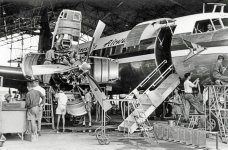 Convair 240-23, showing clamshell engine cowling, Garuda Indonesia 1951 x.jpg271.6 KB · Views: 664
Convair 240-23, showing clamshell engine cowling, Garuda Indonesia 1951 x.jpg271.6 KB · Views: 664 -
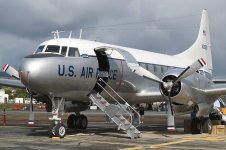 Convair C-131D Samaritan, left front parked, 2006 x.jpg263.2 KB · Views: 681
Convair C-131D Samaritan, left front parked, 2006 x.jpg263.2 KB · Views: 681 -
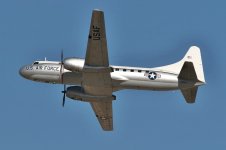 Convair C-131D Samaritan, left low in flight, 2006 x.jpg246.5 KB · Views: 11
Convair C-131D Samaritan, left low in flight, 2006 x.jpg246.5 KB · Views: 11 -
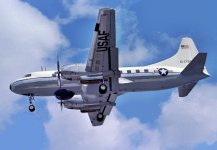 Convair T-29B (240-27), Oslo Sweden 1969 x.jpg253.5 KB · Views: 675
Convair T-29B (240-27), Oslo Sweden 1969 x.jpg253.5 KB · Views: 675 -
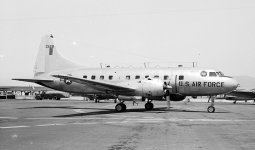 Convair T-29C Navigation Trainer, right ground x.jpg232.1 KB · Views: 673
Convair T-29C Navigation Trainer, right ground x.jpg232.1 KB · Views: 673
Kernel Crittenden
US Veteran, Absent Comrade
The restored cockpit of C-131D 54-2809.

Beginning in 1958 ten C-131/T-29’s were approved for conversion to AC-131A standard with the installation of a single side firing General Electric SUU-11A 7.62-mm Gatling gun with a rate of fire of 6,000 rounds-per-minute. This was called Project Tailchaser, and was the revolutionary testbed for the first fixed wing “Gunship” with a side firing oblique Gatling gun. Funding, fitting and testing of these initial 10 gunship’s languished for years, and faced strong opposition from Air Force brass and strategists. The project was finally green-lighted by legendary General Curtis LeMay who was then USAF Chief of Staff. LeMay’s blessing greased the skids. At long last, live fire tests were conducted in August of 1964. The results were very promising and the project was fast tracked. Four months later three C-47’s were converted in the field and began combat test flights in Vietnam. By late 1965 “Puff the Magic Dragon” was a well known feature in the night skies of Vietnam, loved by friendly ground troops and loathed by the enemy insurgents.
A General Electric SUU-11A gun pod in the door of an AC-47.

The fact that the AC-47 “Gooney Bird” became the first operational gunship platform was really and accident of history. After the first C-47 tests proved the concept in 1964, the AF wanted to go forward and build about 100 gunships using the C-131 as the primary platform. This was due to the fact the C-131 was newer, far more powerful, had a much greater payload, and longer range; compared to the war wary 1940’s era C-47. However, bean counters in the Pentagon nixed the idea (McNamara’s “Wiz Kids“ strike again). In the end, it was deemed cost ineffective to introduce a new combat aircraft type to Vietnam which would be used in such relatively small numbers. So the C-47, despite being less than ideal, was reluctantly selected due to it’s prolific availability, abundant trained mechanics, and plentiful spare parts - all of which were already in country and part of the existing supply chain.
C-131D 54-2809 flies formation with a P-51D. This is a good shot showing the vectored exhaust, as noted by a previous poster.

In 1975 the T-29 was retired from USAF service as a primary navigation trainer. At it’s peak in the 1950’s the USAF operated nearly 2,500 multi-engine medium and heavy bombers and had a great need for navigators and bombardiers. By the 1970’s the number of strategic bomber aircraft had dwindled to a few hundred. With no need to train vast numbers of navigators, in the 1970’s many T-29 were stripped of their specialized navigation and electronics gear, returned to cargo configuration, and sold to civilian operators or transferred to the Tactical Air Command and Air National Guard. The last Air Force unit to operate this aircraft was the Connecticut ANG 103rd TFG at Bradley IAP. It’s last C-131E leaving service in 1983.
The USN continued to operate a few VC-131F/G/H VIP transports. The last USN flight being recorded in 1990. One C-131D, ex USAF 54-2809, was restored from the ground up to pressurized status, completed in 2005, and is operated on the US air show circuit by the Commemorative Air Force (CAF). As of 2015 a small number of C-131 and ex T-29’s are still flying in civilian charter cargo use.
The fully restored C-131D 54-2809 in flight, 2006.

Finally, in a tragic event that occurred the night of October 20, 1977, six persons were killed, including three members of the seminal southern rock band Lynyrd Skynyrd when their Convair CV-300 (a modified 240-17) crashed near Gillsburg, Mississippi. At the peak of their career, among those killed were lead singer Ronnie Van Zant, and guitarist Steve Gaines. The probable cause of the crash was fuel exhaustion resulting in a total loss of power to both engines. The pilot and co-pilot were among the dead. Some 20 other passengers survived.
A United Airlines CV-340-31 in flight.

Beginning in 1958 ten C-131/T-29’s were approved for conversion to AC-131A standard with the installation of a single side firing General Electric SUU-11A 7.62-mm Gatling gun with a rate of fire of 6,000 rounds-per-minute. This was called Project Tailchaser, and was the revolutionary testbed for the first fixed wing “Gunship” with a side firing oblique Gatling gun. Funding, fitting and testing of these initial 10 gunship’s languished for years, and faced strong opposition from Air Force brass and strategists. The project was finally green-lighted by legendary General Curtis LeMay who was then USAF Chief of Staff. LeMay’s blessing greased the skids. At long last, live fire tests were conducted in August of 1964. The results were very promising and the project was fast tracked. Four months later three C-47’s were converted in the field and began combat test flights in Vietnam. By late 1965 “Puff the Magic Dragon” was a well known feature in the night skies of Vietnam, loved by friendly ground troops and loathed by the enemy insurgents.
A General Electric SUU-11A gun pod in the door of an AC-47.
The fact that the AC-47 “Gooney Bird” became the first operational gunship platform was really and accident of history. After the first C-47 tests proved the concept in 1964, the AF wanted to go forward and build about 100 gunships using the C-131 as the primary platform. This was due to the fact the C-131 was newer, far more powerful, had a much greater payload, and longer range; compared to the war wary 1940’s era C-47. However, bean counters in the Pentagon nixed the idea (McNamara’s “Wiz Kids“ strike again). In the end, it was deemed cost ineffective to introduce a new combat aircraft type to Vietnam which would be used in such relatively small numbers. So the C-47, despite being less than ideal, was reluctantly selected due to it’s prolific availability, abundant trained mechanics, and plentiful spare parts - all of which were already in country and part of the existing supply chain.
C-131D 54-2809 flies formation with a P-51D. This is a good shot showing the vectored exhaust, as noted by a previous poster.
In 1975 the T-29 was retired from USAF service as a primary navigation trainer. At it’s peak in the 1950’s the USAF operated nearly 2,500 multi-engine medium and heavy bombers and had a great need for navigators and bombardiers. By the 1970’s the number of strategic bomber aircraft had dwindled to a few hundred. With no need to train vast numbers of navigators, in the 1970’s many T-29 were stripped of their specialized navigation and electronics gear, returned to cargo configuration, and sold to civilian operators or transferred to the Tactical Air Command and Air National Guard. The last Air Force unit to operate this aircraft was the Connecticut ANG 103rd TFG at Bradley IAP. It’s last C-131E leaving service in 1983.
The USN continued to operate a few VC-131F/G/H VIP transports. The last USN flight being recorded in 1990. One C-131D, ex USAF 54-2809, was restored from the ground up to pressurized status, completed in 2005, and is operated on the US air show circuit by the Commemorative Air Force (CAF). As of 2015 a small number of C-131 and ex T-29’s are still flying in civilian charter cargo use.
The fully restored C-131D 54-2809 in flight, 2006.
Finally, in a tragic event that occurred the night of October 20, 1977, six persons were killed, including three members of the seminal southern rock band Lynyrd Skynyrd when their Convair CV-300 (a modified 240-17) crashed near Gillsburg, Mississippi. At the peak of their career, among those killed were lead singer Ronnie Van Zant, and guitarist Steve Gaines. The probable cause of the crash was fuel exhaustion resulting in a total loss of power to both engines. The pilot and co-pilot were among the dead. Some 20 other passengers survived.
A United Airlines CV-340-31 in flight.
Attachments
-
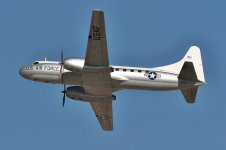 Convair C-131D Samaritan, left low in flight, 2006 x.jpg246.5 KB · Views: 662
Convair C-131D Samaritan, left low in flight, 2006 x.jpg246.5 KB · Views: 662 -
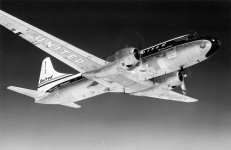 Convair 340, United Airlines N73102, a model 340-31, low left x.jpg275.2 KB · Views: 661
Convair 340, United Airlines N73102, a model 340-31, low left x.jpg275.2 KB · Views: 661 -
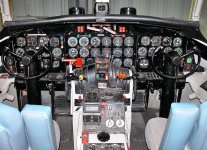 Convair C-131D, USAF 54-2809, CAF restoration cockpit 2002 x.jpg288.5 KB · Views: 668
Convair C-131D, USAF 54-2809, CAF restoration cockpit 2002 x.jpg288.5 KB · Views: 668 -
 General Electric SUU-11A 7.62-mm Gatling gun in the door of an AC-47 x.jpg269.7 KB · Views: 661
General Electric SUU-11A 7.62-mm Gatling gun in the door of an AC-47 x.jpg269.7 KB · Views: 661 -
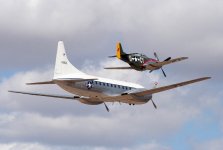 Convair C-131D Samaritan flies formation with a North American P-51D, Luke AFB 2005 x.jpg282.8 KB · Views: 662
Convair C-131D Samaritan flies formation with a North American P-51D, Luke AFB 2005 x.jpg282.8 KB · Views: 662
Similar threads
- Replies
- 39
- Views
- 961
- Replies
- 25
- Views
- 13K
- Locked
- Replies
- 26
- Views
- 10K
- Replies
- 47
- Views
- 8K
- Locked
- Replies
- 45
- Views
- 7K

